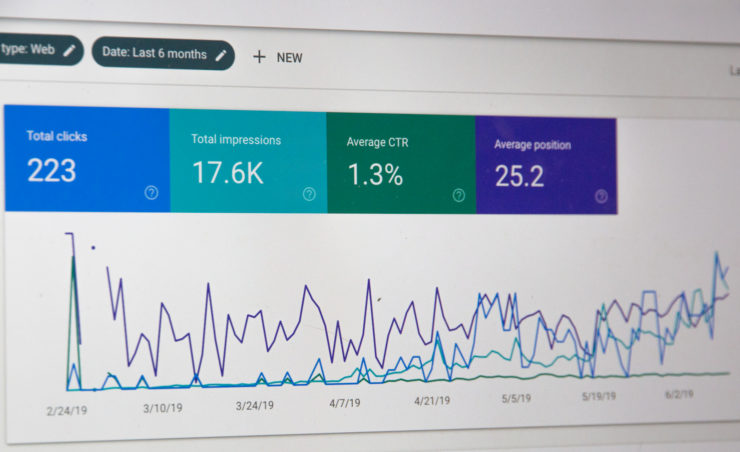Are you more left-brained or right-brained? Deciding between data-driven and creative marketing is a personal preference for each marketer and business. But there are some guidelines for knowing which side to take. Data answers the questions of when, why, and what. Creativity, on the other hand, comes into play with how. But this isn’t always the case.
So do you think you’re more of a data director or a creative connoisseur? We’ve done the research, you decide who won you over.
Data-driven Marketing
Data-driven marketing optimises your brand based on vital information about the customer. This data predicts their needs, desires, and behaviours to create insights that aid your ROI. Data-driven marketing emerged with the rise of digitalisation. Before marketers could analyse the online behaviour of their customers, they went primarily on instinct. How times have changed, turning marketing into a quantifiable process.

Targeting your audience
Insights produced by data turn prospects into buyers. This helps you develop a deeper understanding of who your audience is. Data-driven marketing can then target these demographics that resonate with your brand based on how they interact with you. This is extremely important once you have a following and before you release a big campaign. By understanding how they behave will help not only you but them too. You’re giving them what they want, building rapport, and translating that into engagement.
Boost & Measure results
As well as boosting your return on investment, data also tells you how you’re performing. Informed insights drive your decisions as a marketer, helping you measure and track future results. Data can give you an understanding of your customers’ response to your campaigns to tweak.
Marketing is constantly evolving, making it hard to keep up, but a lot easier with data to help. If one strategy isn’t performing well, it is easy to analyse and find an alternative.
Consistency
It’s hard to say data-driven is more important than creativity, but there is evidence that data-driven marketing should come first, followed by creative execution. Consistently hitting a goal comes from data, as we will say again, numbers don’t lie. Long-term strategies tend to collect and measure then refine data in order to execute marketing at a faster rate. Creativity is beautiful, but if done wrong, it can sometimes be hit and miss. In saying that however, using too much data can lead to limited innovation.

Creative Marketing
Creative marketing isn’t only thinking outside the box. It involves tactics to leave a memorable and positive experience for prospects. Creative marketing is a big accelerator for brand recognition and long-term sales.
Emotions are essential
We all make decisions based on our emotions. This is why emotion is extremely powerful when done right. You can have an abundance of data about the time and place to market. But if you don’t have the right, impactful message, you don’t have your sale. Emotion will encourage decision making and push your audience to take action. It is what lets businesses reach milestones in their marketing efforts. When it comes to online engagement, content thrives off shares, clicks and likes. In a fast-paced world, this is exactly what emotion will persuade your audience to do. Your business needs to appeal to your audience’s needs, wants and behavioural instincts.
All numbers, no innovation
Common reasons for most brands going viral is because they do something no one else has done before. This concept is particularly important when it comes to standing out from your competitors. To capture attention, your business needs unique, memorable content. The market is saturated with the noise of the competitor’s campaigns and advertisements. It’s time to stand out.
Building brand recognition is essential. This comes from the originality of creative marketing. The tactics of creative marketing will not only make a bang but stick with the public for the long term.
Here to stay
When launching big campaigns, you need creativity. Creative marketing will grab your audience’s attention and keep it. Established brands such as Apple and McDonalds have built their brand through creative marketing. Because of these strategies, they’re globally recognised by the even simplest of indicators. If that doesn’t scream long term, I don’t know what will.
Another side to ‘long-term’ comes stability. As we progress to a more digitised world, the process of data-driven marketing has the potential to become automated. This progression will allow marketers to save time, effort and energy for big, creative ideas. The role of creatives will never become redundant and is a huge stand out for your brand.

Is ‘Data-driven creativity’ a thing?
Short answer, yes. Combining both data and creativity is key to ensuring your campaign ticks all the boxes. Most creative strategies come from the information data that insights offer. It is easier creating an astonishing campaign, with the data of who to target, when to launch, and why.
Data lays out the path for creativity to drive it to success.
Here at Web3, we are very much on the data-driven side of things in what we provide as a service. Although, we believe we have the perfect mix of creative hearts and analytical minds within our team.
Listen In
Listen in to what we uncover in our intense debate: Data-driven Vs. Creative marketing, and what is more beneficial for you. It’s bound to have your undivided attention. We’d love to hear your thoughts. Let us know who you agree with, in the comments below.
Transcript
James Banks:
Hello, and welcome to another episode of the Web3 Marketing Debate Show. I’m your host, James Banks.
Joseph Chesterton:
And I’m your host Joseph Chesterton.
James Banks:
And today, we have another spicy, hot out the oven debate on data-driven versus creative marketing. Which one is better for business? So for this debate, I will be taking the creative marketing side of the ring.
Joseph Chesterton:
And I will be taking the data-driven side.
James Banks:
Alrighty, well, without further ado, let’s start the show. So Joseph, why is data-driven marketing better than creative marketing? Before we get started, it would probably be handy to define what data-driven and creative marketing is.
Joseph Chesterton:
So data-driven marketing is a process by which marketers gain insights into trends. These insights are based on in-depth analysis, informed by numbers. Whereas creative marketing is, throw some links and see if it sticks.
James Banks:
Oh, please.
Joseph Chesterton:
I’ll let you back that one up when it comes to it. But anyway, so which one is better? I’m on the data-driven side.
So numbers don’t lie.
You cannot (well, you can) fake numbers when you’re tracking something giving you data. When done correctly, data will provide insights into the decisions you make with marketing. When you track and measure data, it’s important to test and measure.
From there, you’ll be able to produce marketing that is bang on. It will be highly targeted to the specific audience because of the analytics and insights from the data-driven approach.
That’s why I believe data-driven is super important when it comes to marketing. There’s the creative side. So I’ll throw that over to you, James.
James Banks:
Yeah, definitely. Creative is a little bit more than just throwing something against the wall and seeing if it will stick. ‘Creative’ in an agency sense means things such as artwork and imagery. Things such as graphics down to the actual tactical level. But also, creative exists on a strategic level.
I’ll give an example of one of the most memorable advertising campaigns in history. Apple’s 1984 Think Different campaign, an excellent example of creative based advertising. Do you think Steve Jobs and the Apple marketing advertising team pulled up a data-driven report and said:
“You know what? We need to do a reenactment of the 1984 pitcher and have someone throw a sledgehammer into a giant television.”
None.
No data or reporting would have generated the seed for that campaign to then come into existence. And then become one of the most memorable and successful advertising campaigns of all times. That’s the difference between data-driven and creative marketing.
Creative requires genuine human creativity to come up with something that ideally hasn’t been done before. Something that has not been seen or heard from a big picture advertising point of view.
Going down to the tactical execution of campaigns through creative and artwork. It’s vitally important for marketing and advertising campaigns to have the creativity to be successful.
Creativity is a lot harder to do than data-driven marketing and is more valuable and important. Not to discredit data-driven per se, but I do believe it is the more valuable and more important form of marketing between the two. What do you have to say to that, Joseph?
Joseph Chesterton:
Well, it’s exactly that. It is far more difficult to do than collecting numbers. So if you are – *interrupted*
James Banks:
Far more difficult to do well, that is.
Joseph Chesterton:
Yes. When you’re trying to create an ad like what Apple has made, day in and day out, good luck with that. That’s going to be very, very difficult to do.
Whereas if you are marketing based on what the data is telling you, then it will give you far greater insight. It allows you to create marketing that resonates with the specific people you’re targeting. Not the entire world or whoever they were marketing to at the time.
The strategy of collecting and measuring data is long-term. Refining your marketing based on data will allow you to execute your marketing faster, especially opposed to ones requiring creative thinking and creative excellence every single time.
That sh*t is expensive.
With that said, why do you say that creative marketing is the better long-term strategy, James?
James Banks:
Because for the time being, and I hope it stays like this indefinitely. You can’t programme an AI or machine learning bot to produce creative marketing, meaning, creative in the sense of breakthrough campaigns.
There are things out there that can produce banners, for example. You can preset some conditions and it starts churning out banner ads and things like that for you. But the big picture creative is going to be is something that will and should always hold within the domain of great human advertisers.
Data-driven marketing, on the other hand, is exactly that. It is a bunch of numbers inputted, interpreted, then generated. Those insights then lead to action and optimization efforts.
We’ve already seen for the last five-plus years, the big guys in the field, such as Google and Facebook. They are progressively increasing the sophistication of their algorithms, specifically, their AIs and their machine learnings around their advertising platform.
And the AIs are doing exactly what a good data-driven marketer would be – interpret the data, generate insights, formulate a hypothesis, then edit, action, and optimise the campaign accordingly.
Which poses the question:
What is the role of a modern marketer and advertiser with the increasing sophistication of these algorithms that are taking time away that could be spent driving and optimising a data-driven campaign?
That’s why I believe creative, that is big, shock, creative marketing, will ultimately have a greater lifespan between the two. What do you have to say to that, Joseph?
Joseph Chesterton:
I tend to agree that creative will always be a key aspect of marketing. But I believe that there’s going to be a hybrid approach where we do utilise things like Facebook and Google that are always collecting our data.
When we utilise the data they’re collecting, that’s readily available and we’re freely giving to them, then we’ll be able to make decisions far quicker than having to think of some stroke of genius each time. In which case, creativity can be built on top of data, and ideas can be generated easier.
They go hand in hand. You can’t do one without the other.
Although, you can probably do creative once. But to be able to replicate that, you then need to be tracking the data. And to measure the results so that they can be as best as they possibly can be. Do you think that creative marketing is better than data-driven, or do you agree that they go hand in hand?
James Banks:
I think the big picture ultimately means that data-driven… let’s just break this down into specifics. So, data-driven optimization on a marketing and advertising campaign, in the long-term will be taken over.
Machine learning and algorithms will be able to do it faster and better than humans.
It’s not the case now. Don’t get me wrong. But it will be. I think it will be here in a much shorter timeframe than a lot of marketers and advertisers believe it will come.
But I don’t see that as a bad thing. I’m not scared of it. I think that’s a great thing.
Marketers and advertisers can spend the time, effort, energy on the big creative ideas. The things that have been sidelined over the last 10 to 20 years with the advent of digital marketing. The focus of digital marketing and advertising since its inception has been able to collect real, meaningful data in the first place. But also, how to understand, interpret and turn it into insights and actions that lead to results.
Now that the industry is growing more sophisticated tactics and strategies, they’re starting to test, swipe and deploy. This leaves a massive gap for big picture creativity. I really hope that the industry moves back to big ideas, big creatives.
For us at Web3, we are very much on the data-driven side of things in what we actually do as a service. And I have massive respect for creative marketers and advertisers that do these big picture campaigns.
But the future is a combination of both.
Optimization and day to day are going to be taken care of by things such as machine learning. This will allow marketers and advertisers to focus on the big picture, big idea and creative campaigns. This will move the needle and provide what I hope is more value to the audiences that they’re looking to serve.
Joseph Chesterton:
Well said. Okay. That’s a wrap.
James Banks:
I think that’s a wrap too, Joseph. So with that said, ladies and gentlemen, thanks again for tuning in to another episode of the Web3 Marketing Debate Show.
Thank you for listening, and have a nice day.
And that’s a wrap for this episode of the Marketing Debate show. If you liked it, please give us a positive rating on your preferred podcasting platform.
Here are the most recent previous episodes:
- Content Vs Design: Which One is More Valuable for Your Business?
- Content Marketing VS SEO: Which one has the better ROI?
- Building Better Landing Pages: Dedicated Software vs Existing Website
And here’s the very next episode: Brand Awareness Vs. Lead Generation: What delivers the best result for your marketing investment?


